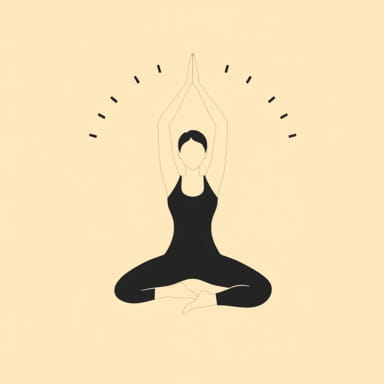Carpal Tunnel Syndrome is a condition that causes numbness, tingling, or pain in the hand and arm due to pressure on the median nerve as it travels through the carpal tunnel in the wrist. Many people develop symptoms from repetitive motions like typing or using a mouse for long hours. Yoga can serve as a natural remedy to ease these symptoms by improving posture, increasing flexibility, and reducing muscle tension. With targeted movements and mindful stretches, yoga for carpal tunnel offers both preventive and therapeutic benefits.
Understanding Carpal Tunnel Syndrome
What Causes Carpal Tunnel?
The condition typically occurs when the carpal tunnel a narrow passageway in the wrist becomes inflamed or compressed. This pressure affects the median nerve, leading to discomfort in the wrist, thumb, and first few fingers. Several factors contribute to the development of carpal tunnel syndrome, including:
- Repetitive hand and wrist motions
- Poor posture and ergonomics
- Inflammatory conditions like arthritis
- Fluid retention, especially during pregnancy
- Underlying health issues such as diabetes
Why Yoga Helps
Yoga provides a gentle and effective way to address the muscular and postural imbalances that lead to carpal tunnel pain. By stretching the forearms, shoulders, and neck, yoga improves circulation and relieves pressure on the wrist. Furthermore, practicing yoga enhances overall body awareness, helping individuals notice early signs of discomfort and correct them before the condition worsens.
Top Yoga Poses for Carpal Tunnel Relief
Prayer Pose (Anjali Mudra)
This simple gesture can help stretch the wrists and promote flexibility.
- Sit comfortably with your spine tall.
- Bring your palms together in front of your chest.
- Press your hands together gently, feeling the stretch in your wrists.
- Hold for 30 seconds and release.
Reverse Prayer Pose (Pashchima Namaskarasana)
This pose deepens the stretch in the wrists and opens the shoulders.
- Stand or sit with a straight back.
- Bring your arms behind you and press your palms together facing upward along the spine.
- If this is difficult, simply grab opposite elbows instead.
- Hold for 30-60 seconds while breathing deeply.
Tabletop Wrist Stretch
This pose gently stretches the muscles and tendons in the hands and wrists.
- Start on all fours in a tabletop position.
- Turn your fingers backward so they face your knees.
- Gently lean back, feeling a stretch in your forearms and wrists.
- Hold for 30 seconds, then relax.
Eagle Arms (Garudasana Arms)
This stretch targets the shoulders and upper back, helping relieve nerve tension radiating from poor posture.
- Sit or stand tall.
- Extend your arms forward and cross the right arm under the left.
- Bend both elbows and try to press your palms together.
- Lift your elbows while dropping the shoulders.
- Hold for 30 seconds and switch sides.
Neck and Shoulder Rolls
Since shoulder and neck tension can worsen wrist pain, releasing those areas is essential.
- Sit in a comfortable position with relaxed shoulders.
- Roll your shoulders forward and backward in circular motions.
- Gently tilt your neck from side to side.
- Inhale and exhale slowly with each motion.
Breathwork and Mindfulness
Diaphragmatic Breathing
Deep breathing relaxes the muscles and reduces stress, which can otherwise amplify pain.
- Sit or lie comfortably and place one hand on your belly.
- Inhale through your nose, allowing your belly to rise.
- Exhale slowly through your mouth, feeling your belly fall.
- Continue for 3-5 minutes.
Mindful Movement
Yoga encourages being present with each stretch. When you move slowly and attentively, you reduce the risk of straining the wrists further. Always pay attention to how your wrists and hands feel in every pose and avoid forcing any position.
Yoga Modifications for Carpal Tunnel
Use of Props
- Yoga blocks can elevate the floor and reduce wrist angle in poses like downward-facing dog.
- A rolled towel or blanket can cushion the wrists and forearms.
- Wrist braces or wraps may help limit extreme angles during practice.
Pose Adjustments
Many traditional yoga poses can strain the wrists, especially when they bear weight. Modify or avoid poses like plank, chaturanga, and downward-facing dog during flare-ups. Instead, focus on seated or supine poses that target the arms and shoulders without stressing the hands.
Preventing Future Flare-Ups
Practice Regularly
Consistency is key. Even 10-15 minutes of yoga per day can maintain flexibility and reduce stiffness in the wrists, arms, and shoulders.
Ergonomic Awareness
- Set up a workstation that supports wrist alignment.
- Use ergonomic keyboards and mouse pads with wrist support.
- Take regular breaks to stretch and rest the hands.
Strengthen Supporting Muscles
Yoga also helps build strength in the core, back, and shoulders, which improves posture and reduces pressure on the wrists. Over time, this redistributes strain and prevents the overuse that contributes to carpal tunnel syndrome.
When to Seek Medical Advice
While yoga can greatly reduce symptoms, some cases of carpal tunnel may require medical intervention. If you experience severe pain, muscle weakness, or worsening symptoms, consult a doctor or physical therapist. Yoga can still complement clinical treatment, but safety should always come first.
Yoga offers a gentle, holistic approach to managing and preventing carpal tunnel syndrome. Through targeted stretches, mindful breathing, and modified movements, you can ease pressure on the wrists, reduce inflammation, and restore flexibility. By incorporating yoga into your regular routine and being mindful of repetitive stress, you can support long-term wrist health and regain comfort in everyday tasks. Whether you’re a beginner or experienced practitioner, yoga for carpal tunnel can be adapted to meet your body’s unique needs one breath, one pose at a time.
